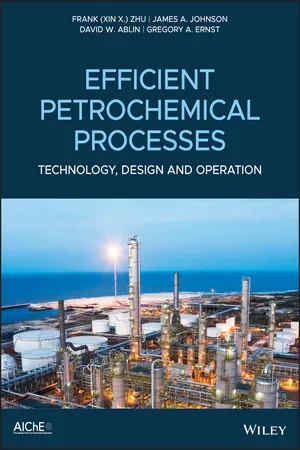
Efficient Petrochemical Processes
Technology, Design and Operation
- English
- ePUB (mobile friendly)
- Available on iOS & Android
Efficient Petrochemical Processes
Technology, Design and Operation
About This Book
A GUIDE TO THE DESIGN, OPERATION, CONTROL, TROUBLESHOOTING, OPTIMIZATION AS WELL AS THE RECENT ADVANCES IN THE FIELD OF PETROCHEMICAL PROCESSES
Efficient Petrochemical Processes: Technology, Design and Operation is a guide to the tools and methods for energy optimization and process design. Written by a panel of experts on the topic, the book highlights the application of these methods on petrochemical technology such as the aromatics process unit. The authors describe practical approaches and tools that focus on improving industrial energy efficiency, reducing capital investment, and optimizing yields through better design, operation, and optimization.
The text is divided into sections that cover the range of essential topics: petrochemical technology description; process design considerations; reaction and separation design; process integration; process system optimization; types of revamps; equipment assessment; common operating issues; and troubleshooting case analysis. This important book:
- Provides the basic knowledge related to fundamentals, design, and operation for petrochemical processes
- Applies process integration techniques and optimization techniques that improve process design and operations in the petrochemical process
- Provides practical methods and tools for industrial practitioners
- Puts the focus on improving industrial energy efficiency, reducing capital investment, and optimizing yields
- Contains information on the most recent advances in the field.
Written for managers, engineers, and operators working in process industries as well as university students, Efficient Petrochemical Processes: Technology, Design and Operation explains the most recent advances in the field of petrochemical processes and discusses in detail catalytic and adsorbent materials, reaction and separation mechanisms.
Frequently asked questions
Information
Part I
Market, Design and Technology Overview
1
Overview of This Book
1.1 Why Petrochemical Products Are Important for the Economy
1.1.1 Polyethylene
1.1.2 Polypropylene
1.1.3 Styrene and Polystyrene
Table of contents
- Cover
- Table of Contents
- Preface
- Acknowledgments
- Part I: Market, Design and Technology Overview
- Part II: Process Design
- Part III: Process Equipment Assessment
- Part IV: Energy and Process Integration
- Part V: Operational Guidelines and Troubleshooting
- Index
- End User License Agreement